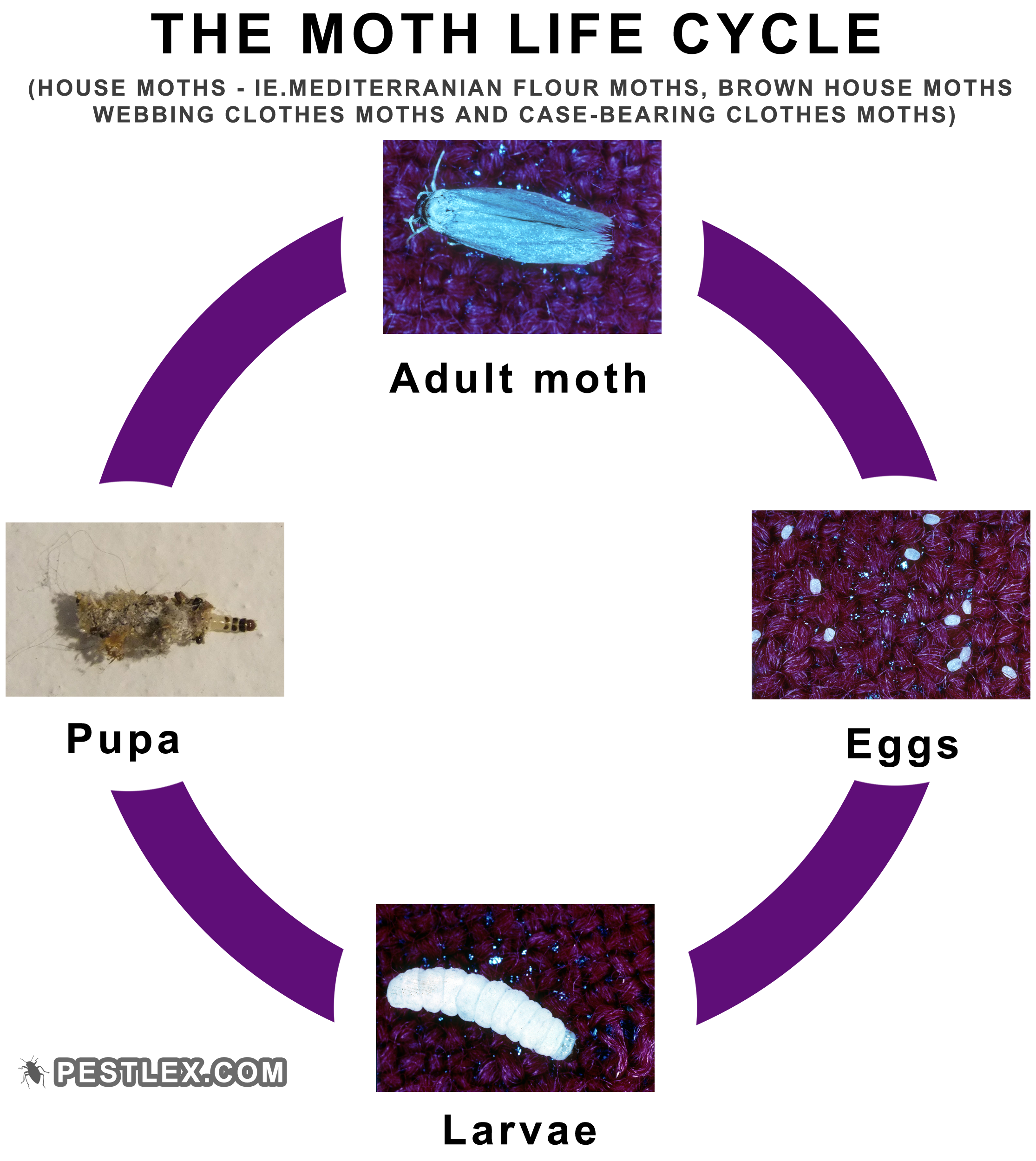The 4 Stages of the Life Cycle
Most moths have a life cycle that can be divided into four stages:
- Adult moth
- Egg
- Larva
- Pupa
You can find a more detailed review of this cycle below.
Note: This article only covers house moths (i.e., clothes moths, brown house moths, Indian meal moths, and Mediterranean flour moths) – not the other 160,000 moth species!

Stages of the Life Cycle
The moth’s life cycle can be broken down into four stages:
1. Adult Moth
- Mating: Adult moths mate immediately after emerging from their pupae. The timing of mating varies by species but often occurs within the first few days or at the latest, within the first couple of weeks after hatching. The total lifespan of an adult moth can range from just a few days to over a month.
- Egg Laying: Adult moths lay their eggs directly on the larvae’s future food source. For moths that attacks clothing, this would be organic textiles (e.g., in a wardrobe), and for food moths, it’s dry food products (e.g., in a kitchen cabinet). Some species can also lay their eggs on plant or animal materials. The number of eggs laid depends on the moth species and can range from 40 to 600 during the moth’s lifetime.
2. Egg
- Hatching Time: The hatching time of the eggs largely depends on the temperature and humidity of the environment (and the moth species), but under the right conditions, hatching typically occurs after 4 to 30 days. However, it can take several months.
- Hatching Process: When the egg hatches, the moth larva emerges and immediately starts feeding on the nearest food source, which is usually the material on which it was laid. Read more about moth eggs here.
3. Larva
- Food: The larval stage begins when the larva hatches, at which point it begins to feed on its surroundings. If the larva is not on a material it can feed on, it will immediately seek out a suitable source. For example, clothes moths can chew through synthetic textiles to reach organic textiles they can live on, while food moths can crawl through very small holes in packaging to access the food inside.
- Nourishment: The moth larva needs a lot of nourishment to develop into an adult moth in the next stage, the pupa. During the larval stage, the larva molts 5 to 45 times. Larvae that hatch in areas with enough food rarely move around. However, larvae without enough food will actively seek it and may wander around. The duration of the larval stage varies greatly depending on temperature, humidity, and the moth species. This stage can last from 35 days to 2½ years.
4. Pupa
- Pupa: The larva spins a cocoon, or pupa, to pupate. The purpose of this is to protect the larva from drying out and other environmental disturbances while it develops into an adult moth. The pupal stage begins when the larva pupates and ends when the adult moth emerges from its cocoon. Like the other stages, the duration of the pupal stage depends on the environment and moth species.
- Behavior: Different moth species exhibit different behavior during the pupal stage. For example, brown house moths drag their cocoons around, while other moths attach their cocoons to their food sources and do not move around.
Generations
There can be between 1 and 9 generations per year. The number of generations largely depends on the moth species as well as the temperature and humidity of the environment.
The optimal temperatures for most species range between 20 and 30 degrees Celsius. All moths, larvae, and eggs die if heated to 60 degrees for one hour. Although they can survive freezing temperatures, most will die at -18 degrees Celsius if exposed for at least two days. Moths are also sensitive to large temperature fluctuations, and alternating cold and warm conditions will kill them.
Humidity is particularly important for brown house moths, as their development slows or stops if there isn’t enough moisture in their surroundings.
Additional Information
If you are dealing with a moth infestation and are unsure of the moth species, you can find out more in our guide to moth species.
You can also learn more about the life cycles of individual moth species in their respective articles:
